Do you have a question about the Sony Handycam CCD-TR402E and is the answer not in the manual?
Read this manual thoroughly before operating the unit and retain it for future reference.
To prevent fire or shock hazard, do not expose the unit to rain or moisture or open the cabinet.
Details on the fitted plug, fuse replacement, and fuse cover for UK customers.
Explains how to use the manual, indicating buttons, settings, and model differences.
Information on PAL, SECAM, and NTSC systems for viewing playback on a TV.
Warning about unauthorized recording of copyrighted materials.
Keep the camcorder away from water, sand, dust, and extreme heat to prevent damage.
Verify that all listed accessories like remote commander, battery pack, cables, and adaptor are provided.
Instructions on how to charge the battery pack using the AC power adaptor, including charging time.
Details on typical and continuous recording times for various battery packs.
Use the battery completely before recharging to maintain its capacity.
Instructions on how to slide and remove the battery pack from the camcorder.
Important notes regarding the POWER lamp and operating the camcorder during charging.
Steps to insert the battery pack firmly into the camcorder, ensuring it clicks twice.
Instructions on how to slide and pull the lower part of the battery pack to remove it.
Steps to open the compartment, insert a cassette, and close the compartment.
How to use the tab on the cassette to prevent accidental erasure when recording.
Steps to set the camcorder to CAMERA mode, select START/STOP mode, and begin recording.
Information on the AUTO DATE feature, which records date for 10 seconds after starting.
How to stop recording momentarily or finish recording and power off the camcorder.
Notes on automatic camcorder shutdown in standby and how to focus the viewfinder lens.
Explanation of indicators that appear only in CAMERA mode.
How to record using START/STOP button and short takes with 5 SEC mode.
Information on SP and LP recording modes and playback quality.
Using the tape counter and disabling the beep sound for operations.
How the AUTO DATE feature works and adjusting white balance when changing environments.
How to use the zoom feature to change subject size, with tips for professional results.
Adjusting zoom speed and focusing tips for telephoto zoom.
Explanation of optical and digital zoom, and how quality degrades with digital zoom.
Recommendations for holding the camcorder firmly and supporting it for better stability.
Detailed instructions on how to hold the camcorder, use a tripod, and ensure stability.
Warnings about picking up the camcorder by the viewfinder or pointing it at the sun.
How to use EDITSEARCH to review the last recorded scene or check pictures in the viewfinder.
How to stop playback and begin re-recording from a specific point.
Instructions for connecting the camcorder to a VCR for playback on a TV screen.
How to connect the camcorder directly to a TV using the A/V cable.
Using the supplied 21-pin adaptor for TVs/VCRs with a EUROCONNECTOR.
Using an RFU adaptor (not supplied) to connect to TVs or VCRs lacking specific input jacks.
Steps to set the camcorder to PLAYER mode and start playback using buttons or remote.
Functions of buttons for stopping, rewinding, and fast-forwarding the tape.
How to use the supplied remote commander for playback control.
Do not open the lens cover manually; it may cause malfunction.
Using still picture, picture search, and skip scan playback modes.
Details on using mains, battery pack, alkaline batteries, or car battery for power.
Warnings about disconnecting power during recording and the meaning of the Genuine Video Accessories mark.
Instructions on connecting the AC power adaptor to the mains and camcorder.
Safety warnings for mains lead, power disconnection, and POWER lamp behavior.
How to insert batteries into the case and attach it to the camcorder.
Battery life estimates for alkaline batteries and notes on usage conditions.
How to connect and use the Sony DC pack with a car battery for power.
How to record the date or time with the picture, and how to stop this feature.
Choosing between Sports, High-speed shutter, and Twilight modes for various shooting situations.
Details on shutter speed settings for Sports, High-speed shutter, Twilight, and AUTO modes.
How to use the BACK LIGHT function to improve picture quality when shooting subjects with backlight.
Situations where backlight compensation is particularly useful, like snowy scenes or bright backgrounds.
Explanation of normal, ANTI GROUND SHOOTING, and 5 SEC modes for different recording styles.
How to extend recording time in the 5 SEC mode by pressing START/STOP before dots disappear.
How to select and superimpose preset titles from the beginning or during recording.
A note stating that titles cannot be selected while recording.
How to set the camcorder to record 16:9 wide pictures for viewing on widescreen TVs.
Information on how date/time indicators appear and how tapes are copied in wide mode.
How to slide the cover to access and set mode switches for ZOOM, COMMANDER, BEEP, and REC MODE.
Detailed descriptions of ZOOM, COMMANDER, BEEP, and REC MODE settings.
Steps for editing video from one tape to another using VCRs with video/audio inputs.
How to repeat editing steps or stop the editing process.
Instructions for replacing the weak or dead lithium battery with a Sony CR2025.
Important notes on keeping the battery away from children, avoiding short circuits, and proper installation.
Detailed steps on how to slide the cover, remove the old battery, and install the new lithium battery.
How to set the year, month, day, time, and minute using the DATE(+) and TIME(NEXT) buttons.
How to correct or check the set date and time using the respective buttons.
How the playback mode (SP/LP) is selected based on the recording system.
Considerations for playing back foreign tapes due to differences in TV color systems.
Advice on carrying extra batteries, using the camcorder in cold environments, and saving battery power.
How to interpret the remaining battery indicator and when to replace the battery pack.
Caution about high temperatures and explanation of why the battery pack heats up during use.
Instructions for removing the battery pack, charging it before use, and avoiding partial charging.
How to use the battery pack switch and factors affecting its lifespan.
Optimal charging temperatures, notes on new batteries, and procedures for recharging after long storage.
How to clean terminals, avoid short circuits with metal objects, and keep the battery away from fire.
Notes on using only alkaline batteries, battery life in cold, and avoiding mechanical shock to the case.
Instructions to avoid damage from leakage, including correct battery insertion and avoiding mixing old/new batteries.
Steps to take if battery leakage occurs, including cleaning liquid and seeking medical attention.
How to deal with moisture inside the camcorder, indicated by beep and DEW lamp, and how to leave it to dry.
How to prevent moisture on the lens by acclimatizing the camcorder in a plastic bag.
How to clean video heads using a special cassette if the picture is noisy or barely visible.
Warnings against using wet-type cleaning cassettes and advice on obtaining the correct one.
Steps to remove the eyecup using a screwdriver and clean the surface with a blower.
Instructions on how to align and reattach the eyecup after cleaning.
Safety and operational guidelines for using the camcorder, handling tapes, and protecting it from damage.
Guidelines for using the AC power adaptor, including charging specific battery types and placement during charging.
Warnings regarding unplugging the unit, handling damaged cords, avoiding magnetic fields, and unit warmth.
Information on the intended use of the battery charger and warnings regarding incompatible battery types.
Using the camcorder internationally with a universal AC power adaptor.
Information on PAL, PAL-M, PAL-N, NTSC, and SECAM systems for viewing playback abroad.
Solutions for when the camcorder won't power on, powers off, or the battery discharges quickly.
Solutions for when START/STOP doesn't operate, the cassette won't eject, or the tape doesn't move.
Solutions for unclear viewfinder images, vertical bands, or noisy pictures.
Troubleshooting for a non-working remote commander or dust in the viewfinder.
Steps to take if the POWER lamp does not light or the CHARGE lamp flashes.
A flowchart to diagnose issues when the CHARGE lamp flashes or does not flash.
Solutions for battery not attached, dead battery, power adaptor issues, and excessive standby time.
Troubleshooting for stuck tapes, tape run-out, incorrect power switch settings, and cassette tab issues.
Solutions for moisture condensation, other troubles, and weak or uninstalled lithium batteries.
Solutions for date/time indicators flashing, disappearing, or recording stopping prematurely.
Troubleshooting for unclear pictures, vertical bands, noisy images, and non-functional remote commanders.
A flowchart to diagnose issues when the CHARGE lamp flashes, indicating potential problems with the battery or adaptor.
Technical details of the camcorder, including system, lens, illumination, connectors, dimensions, and mass.
Technical details of the AC power adaptor, including power requirements, consumption, and dimensions.
Explanation of indicators displayed in the viewfinder only when the camcorder is in CAMERA mode.
A guide to identifying various buttons, switches, jacks, and components on the camcorder.
Explanation of the LANC jack's use for wired remote controls and editing controllers.
Identification of additional camcorder parts including power zoom lever, EJECT knob, and microphone jack.
Identification of tape transport buttons, EDITSEARCH button, lens cover, microphone, and remote sensor.
Identification of DEW lamp, viewfinder adjustments, backlight button, PROGRAM AE dial, and mode switches.
Instructions on how to attach the supplied shoulder strap to the camcorder hooks.
Identification of remote commander buttons and their functions, noting identical operation to camcorder controls.
How to insert batteries into the remote commander, including polarity and battery cover replacement.
Notes on battery lifespan and precautions to avoid damage from possible battery leakage.
Aiming the remote commander at the sensor within the specified range for effective control.
Important notes on avoiding light interference, ensuring no obstacles, and compatibility with Sony VCRs.
Steps to enter the demo mode, which shows pictures with titles.
How to exit the demo mode to use the camcorder normally.
Explanation of various indicators that appear in the display window when the camcorder is in CAMERA mode.
Guide to understanding warning indicators like battery status, tape near end, moisture condensation, and other troubles.
Information on how to hear beep sounds for operations and warnings.
Read this manual thoroughly before operating the unit and retain it for future reference.
To prevent fire or shock hazard, do not expose the unit to rain or moisture or open the cabinet.
Details on the fitted plug, fuse replacement, and fuse cover for UK customers.
Explains how to use the manual, indicating buttons, settings, and model differences.
Information on PAL, SECAM, and NTSC systems for viewing playback on a TV.
Warning about unauthorized recording of copyrighted materials.
Keep the camcorder away from water, sand, dust, and extreme heat to prevent damage.
Verify that all listed accessories like remote commander, battery pack, cables, and adaptor are provided.
Instructions on how to charge the battery pack using the AC power adaptor, including charging time.
Details on typical and continuous recording times for various battery packs.
Use the battery completely before recharging to maintain its capacity.
Instructions on how to slide and remove the battery pack from the camcorder.
Important notes regarding the POWER lamp and operating the camcorder during charging.
Steps to insert the battery pack firmly into the camcorder, ensuring it clicks twice.
Instructions on how to slide and pull the lower part of the battery pack to remove it.
Steps to open the compartment, insert a cassette, and close the compartment.
How to use the tab on the cassette to prevent accidental erasure when recording.
Steps to set the camcorder to CAMERA mode, select START/STOP mode, and begin recording.
Information on the AUTO DATE feature, which records date for 10 seconds after starting.
How to stop recording momentarily or finish recording and power off the camcorder.
Notes on automatic camcorder shutdown in standby and how to focus the viewfinder lens.
Explanation of indicators that appear only in CAMERA mode.
How to record using START/STOP button and short takes with 5 SEC mode.
Information on SP and LP recording modes and playback quality.
Using the tape counter and disabling the beep sound for operations.
How the AUTO DATE feature works and adjusting white balance when changing environments.
How to use the zoom feature to change subject size, with tips for professional results.
Adjusting zoom speed and focusing tips for telephoto zoom.
Explanation of optical and digital zoom, and how quality degrades with digital zoom.
Recommendations for holding the camcorder firmly and supporting it for better stability.
Detailed instructions on how to hold the camcorder, use a tripod, and ensure stability.
Warnings about picking up the camcorder by the viewfinder or pointing it at the sun.
How to use EDITSEARCH to review the last recorded scene or check pictures in the viewfinder.
How to stop playback and begin re-recording from a specific point.
Instructions for connecting the camcorder to a VCR for playback on a TV screen.
How to connect the camcorder directly to a TV using the A/V cable.
Using the supplied 21-pin adaptor for TVs/VCRs with a EUROCONNECTOR.
Using an RFU adaptor (not supplied) to connect to TVs or VCRs lacking specific input jacks.
Steps to set the camcorder to PLAYER mode and start playback using buttons or remote.
Functions of buttons for stopping, rewinding, and fast-forwarding the tape.
How to use the supplied remote commander for playback control.
Do not open the lens cover manually; it may cause malfunction.
Using still picture, picture search, and skip scan playback modes.
Details on using mains, battery pack, alkaline batteries, or car battery for power.
Warnings about disconnecting power during recording and the meaning of the Genuine Video Accessories mark.
Instructions on connecting the AC power adaptor to the mains and camcorder.
Safety warnings for mains lead, power disconnection, and POWER lamp behavior.
How to insert batteries into the case and attach it to the camcorder.
Battery life estimates for alkaline batteries and notes on usage conditions.
How to connect and use the Sony DC pack with a car battery for power.
How to record the date or time with the picture, and how to stop this feature.
Choosing between Sports, High-speed shutter, and Twilight modes for various shooting situations.
Details on shutter speed settings for Sports, High-speed shutter, Twilight, and AUTO modes.
How to use the BACK LIGHT function to improve picture quality when shooting subjects with backlight.
Situations where backlight compensation is particularly useful, like snowy scenes or bright backgrounds.
Explanation of normal, ANTI GROUND SHOOTING, and 5 SEC modes for different recording styles.
How to extend recording time in the 5 SEC mode by pressing START/STOP before dots disappear.
How to select and superimpose preset titles from the beginning or during recording.
A note stating that titles cannot be selected while recording.
How to set the camcorder to record 16:9 wide pictures for viewing on widescreen TVs.
Information on how date/time indicators appear and how tapes are copied in wide mode.
How to slide the cover to access and set mode switches for ZOOM, COMMANDER, BEEP, and REC MODE.
Detailed descriptions of ZOOM, COMMANDER, BEEP, and REC MODE settings.
Steps for editing video from one tape to another using VCRs with video/audio inputs.
How to repeat editing steps or stop the editing process.
Instructions for replacing the weak or dead lithium battery with a Sony CR2025.
Important notes on keeping the battery away from children, avoiding short circuits, and proper installation.
Detailed steps on how to slide the cover, remove the old battery, and install the new lithium battery.
How to set the year, month, day, time, and minute using the DATE(+) and TIME(NEXT) buttons.
How to correct or check the set date and time using the respective buttons.
How the playback mode (SP/LP) is selected based on the recording system.
Considerations for playing back foreign tapes due to differences in TV color systems.
Advice on carrying extra batteries, using the camcorder in cold environments, and saving battery power.
How to interpret the remaining battery indicator and when to replace the battery pack.
Caution about high temperatures and explanation of why the battery pack heats up during use.
Instructions for removing the battery pack, charging it before use, and avoiding partial charging.
How to use the battery pack switch and factors affecting its lifespan.
Optimal charging temperatures, notes on new batteries, and procedures for recharging after long storage.
How to clean terminals, avoid short circuits with metal objects, and keep the battery away from fire.
Notes on using only alkaline batteries, battery life in cold, and avoiding mechanical shock to the case.
Instructions to avoid damage from leakage, including correct battery insertion and avoiding mixing old/new batteries.
Steps to take if battery leakage occurs, including cleaning liquid and seeking medical attention.
How to deal with moisture inside the camcorder, indicated by beep and DEW lamp, and how to leave it to dry.
How to prevent moisture on the lens by acclimatizing the camcorder in a plastic bag.
How to clean video heads using a special cassette if the picture is noisy or barely visible.
Warnings against using wet-type cleaning cassettes and advice on obtaining the correct one.
Steps to remove the eyecup using a screwdriver and clean the surface with a blower.
Instructions on how to align and reattach the eyecup after cleaning.
Safety and operational guidelines for using the camcorder, handling tapes, and protecting it from damage.
Guidelines for using the AC power adaptor, including charging specific battery types and placement during charging.
Warnings regarding unplugging the unit, handling damaged cords, avoiding magnetic fields, and unit warmth.
Information on the intended use of the battery charger and warnings regarding incompatible battery types.
Using the camcorder internationally with a universal AC power adaptor.
Information on PAL, PAL-M, PAL-N, NTSC, and SECAM systems for viewing playback abroad.
Solutions for when the camcorder won't power on, powers off, or the battery discharges quickly.
Solutions for when START/STOP doesn't operate, the cassette won't eject, or the tape doesn't move.
Solutions for unclear viewfinder images, vertical bands, or noisy pictures.
Troubleshooting for a non-working remote commander or dust in the viewfinder.
Steps to take if the POWER lamp does not light or the CHARGE lamp flashes.
A flowchart to diagnose issues when the CHARGE lamp flashes or does not flash.
Solutions for battery not attached, dead battery, power adaptor issues, and excessive standby time.
Troubleshooting for stuck tapes, tape run-out, incorrect power switch settings, and cassette tab issues.
Solutions for moisture condensation, other troubles, and weak or uninstalled lithium batteries.
Solutions for date/time indicators flashing, disappearing, or recording stopping prematurely.
Troubleshooting for unclear pictures, vertical bands, noisy images, and non-functional remote commanders.
A flowchart to diagnose issues when the CHARGE lamp flashes, indicating potential problems with the battery or adaptor.
Technical details of the camcorder, including system, lens, illumination, connectors, dimensions, and mass.
Technical details of the AC power adaptor, including power requirements, consumption, and dimensions.
Explanation of indicators displayed in the viewfinder only when the camcorder is in CAMERA mode.
A guide to identifying various buttons, switches, jacks, and components on the camcorder.
Explanation of the LANC jack's use for wired remote controls and editing controllers.
Identification of additional camcorder parts including power zoom lever, EJECT knob, and microphone jack.
Identification of tape transport buttons, EDITSEARCH button, lens cover, microphone, and remote sensor.
Identification of DEW lamp, viewfinder adjustments, backlight button, PROGRAM AE dial, and mode switches.
Instructions on how to attach the supplied shoulder strap to the camcorder hooks.
Identification of remote commander buttons and their functions, noting identical operation to camcorder controls.
How to insert batteries into the remote commander, including polarity and battery cover replacement.
Notes on battery lifespan and precautions to avoid damage from possible battery leakage.
Aiming the remote commander at the sensor within the specified range for effective control.
Important notes on avoiding light interference, ensuring no obstacles, and compatibility with Sony VCRs.
Steps to enter the demo mode, which shows pictures with titles.
How to exit the demo mode to use the camcorder normally.
Explanation of various indicators that appear in the display window when the camcorder is in CAMERA mode.
Guide to understanding warning indicators like battery status, tape near end, moisture condensation, and other troubles.
Information on how to hear beep sounds for operations and warnings.
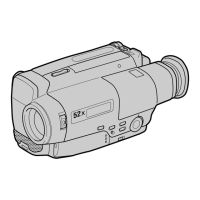

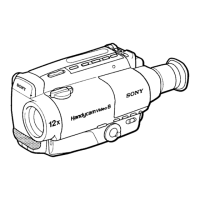

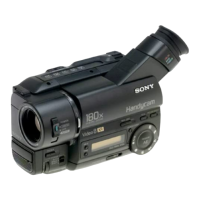

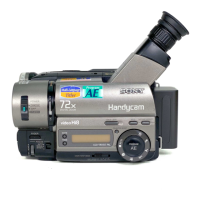
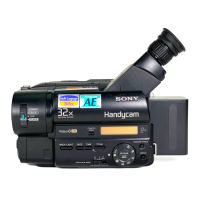
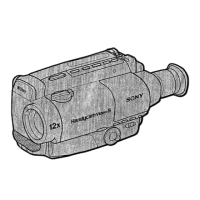


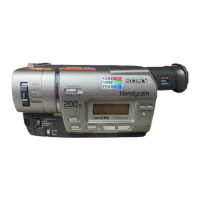
